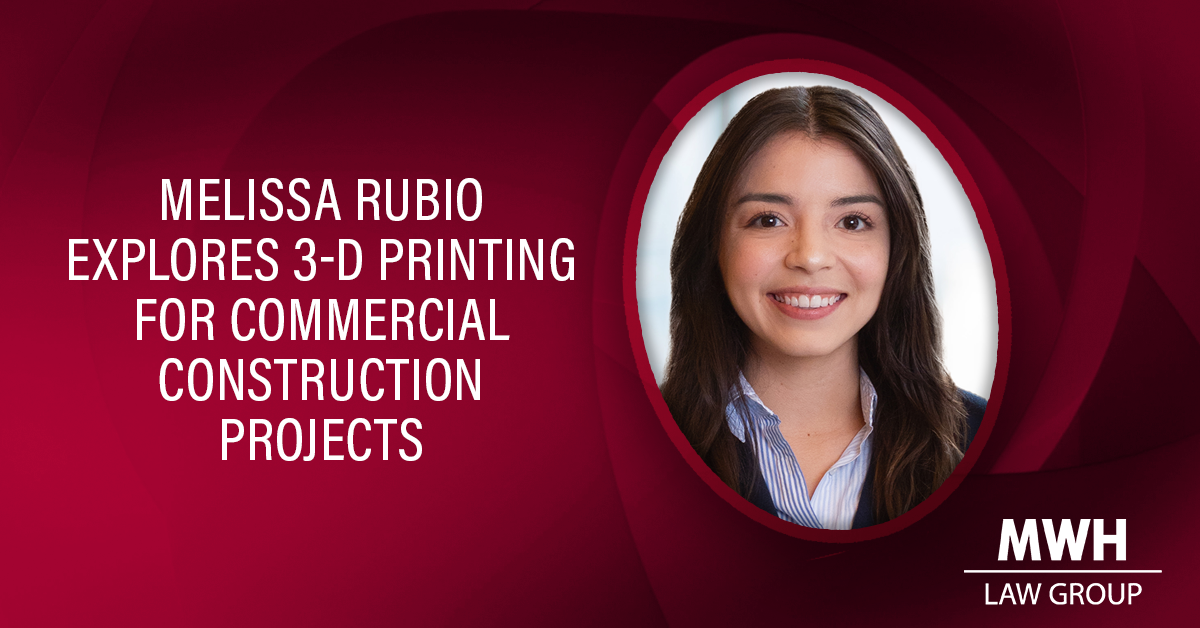Barriers to Entry Stunting Growth of 3-D Printing for Commercial Construction Projects

The potential for commercial use of additive manufacturing, better known as 3-D printing, has grown tremendously in the last decade. Companies are continuously testing 3-D printed items to ascertain the viability of such items in both the company’s own supply chain and for end users. As with most technological advances, the possibilities 3-D printing offers the world are endless. Not only does it produce time and cost savings, but 3-D printing also reduces the possibility of human error. In the field of construction, time and money savings, and the opportunity to decrease potential claims for defects, is particularly enticing for owners and contractors alike. Even though commercial 3-D printers have been available since 2008, their use in construction has been limited given the safety concerns surrounding use of 3-D printed outputs for buildings. These concerns ultimately manifest as legal red tape which has hindered the use of 3-D printing for any construction projects, but particularly commercial builds.
Montana Takes the Lead in Approving 3-D Printing in Construction
In the latter half of 2022, Montana became the first state to grant broad regulatory approval for the use of 3-D printing in construction. The building code regulators’ approval extends on a statewide basis, meaning all builds that follow Montana’s building code are permitted to use 3-D printed walls as an alternative to concrete masonry units or standard cored concrete block assembly. Tim Stark, the local Montana-based contractor who advocated for the use of such 3-D printed walls, presented evidence that he would be able to cut his costs for building residential homes by up to 30%. Fortunately, Montana’s building code was crafted acknowledging that advances such as 3-D printing may serve to change the industry for the better: “The state building code must be designed to . . . permit to the fullest extent feasible the use of modern technical methods, devices, and improvements that tend to reduce the cost of construction consistent with reasonable requirements for the health and safety of the occupants or users of buildings . . . .” Mont. Code § 50-60-201(2) (emphasis added). Although a very recent development, this move by Montana can help other states address the advent of 3-D printing in construction, because building code changes will be inevitable to allow the benefits of 3-D printing in construction to come to fruition.
Looming Uncertainty
3-D printing has been around for several years, and the benefits are clear, so why the delay in its use in construction, specifically for commercial projects? As the technology continues to evolve, there is uncertainty around both the cost of equipment needed to make 3-D printed outputs and the liability for defects resulting from the use of multiple inputs and processes, which requires the involvement and coordination of multiple parties. Further, defect claims are likely to be higher in the beginning as the use of 3-D printing for commercial projects grows; the benefit of reduction in human error is a result that would be observed over time, not one that can be expected to occur instantly.
On the back end, we see the legal process playing catch up. Most building codes now do not contemplate the use of 3-D printed outputs, meaning their use is essentially unregulated. Even for states that do wish to act, there is little guidance on the language that should be used to convey the necessary design, engineering, and safety standards. Recognizing such a need, the International Code Council (“ICC”) attempts to provide such standards. Appendix AW, created by the ICC, includes standards that govern the design, construction, and inspection of 3-D printed builds. Appendix AW also incorporates UL 3401, “UL” standing for Underwriters Laboratories, an organization known for developing safety standards. UL 3401 provides standards for evaluating the 3-D printer itself, the fabrication process, and the inputs used. Similar to other uniform codes, the hope with Appendix AW is that governing bodies use the standards as a baseline, tailoring as necessary, but that for the most part, building codes contain standards from Appendix AW that are uniform from state to state. The legal process itself for actually putting any new standards into place presents a hurdle as well. Although the ICC was able to provide language for use in creating standards, state governments and the public will continue to be hesitant to move forward promulgating such standards where there is not enough data to support the long-term durability and safety of the 3-D builds.
At some point, states will have to take a leap of faith. The use of 3-D printing for residential construction is growing, and as the data starts to develop and parties start to reap the benefits, it is only natural that the use of 3-D printing will extend to commercial projects. States that are proactive in reviewing and pushing forward changes to their building codes will be better equipped to handle what will be a steep learning curve for others when 3-D printing for commercial construction projects becomes increasingly commonplace.
This article is a publication of MWH Law Group LLP and is intended to provide general information regarding legal issues and developments to our clients and other friends. It should not be construed as legal advice or a legal opinion on any specific facts or situations. For further information on your own situation, we encourage you to contact the author of the article or any other member of the firm.
CONTACT ASSOCIATE MELISSA RUBIO

Melissa Rubio, Associate
735 N. Water St., Suite 610
Milwaukee, WI 53202
P: (414) 436-0353 / F: (414) 436-0354
E: melissa.rubio@mwhlawgroup.com

